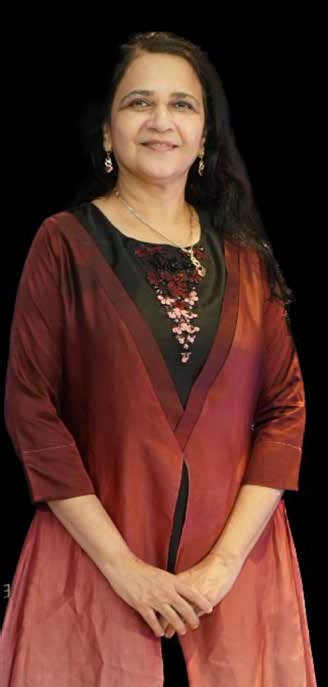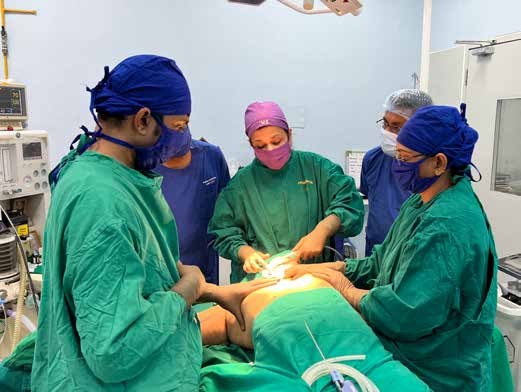Pioneering femininity in surgery
Shriyal Sethumadhavan traces yet another interesting journey in the life of a surgeon, as she converses with Dr Medha Bhave, Plastic Surgeon, Director-Param Hospital and ICU, and Lasercosmesis, about her experiences and how the aesthetic practice has evolved over the years.
Dr Medha Bhave started her practice around 27 years ago in 1996. Initially, she faced resistance in choosing general surgery due to its male-dominated nature. Despite being among the toppers, she was discouraged, but her mother’s support and encouragement fueled her decision. Her mother envisioned her walking out of the operation theater in her own hospital. With her mother’s support, she completed her residency successfully, managing it alongside the responsibilities of marriage and a baby. Realising the need for specialization, Dr. Medha pursued a super-specialty in plastic surgery with unwavering support from her husband and mother. Under the guidance of her visionary teacher, Dr Swarad Arora, she focused on aesthetic plastic surgery and completed a groundbreaking thesis on liposuction – one of the first in the country.
After joining MCH plastic surgery when her daughter was one year old, Dr Medha initially engaged in trauma and reconstructive work. In 2000, she purchased one of the first laser machines in Mumbai, significantly impacting her practice. This marked the beginning of a shift toward aesthetic solutions, with her liposuction and laser practice gaining traction. As her results became visible, patients began to trust, and through word of mouth, her practice expanded. Excerpts from her journey:
At the start of your career, this used to be amaledominated area. How has your experience evolved over the years?
There has been a positive change. More and more girls are now pursuing super-specialty fields. In the past, most women would stop at post-graduation, but now they are venturing into superspecialisation, and there is a growing number of girls entering the field of surgery. It is often said that a surgeon should have “ladies’ fingers and a lion’s heart.” Women inherently possess delicate fingers and lion-hearted courage, as they must prioritise taking care of their children at any cost. Consequently, they are wellsuited to become surgeons. Over time, the number of women in plastic surgery has significantly increased. Not only are more girls pursuing super-specialisation, but they are also traveling abroad to enhance their knowledge, undergo fellowships, and return to confidently establish their practices. This trend is particularly crucial in aesthetic surgery, where having more female plastic surgeons is essential because around 90 per cent of patients are women. Although this trend is gradually changing, with more men seeking aesthetic procedures, having female plastic surgeons can contribute to better patient relations, especially in procedures predominantly sought by women.

While today you serve as a mentor to many, who has been your mentor?
I have had quite a few mentors, including my mother, as I mentioned earlier. Her most important lesson was that whatever you become, your children will remember what you fed them. Cooking at home sometimes is essential, and this approach has worked well for me. It is a way to stay connected with your children. So, in addition to focusing on your career, you can balance your family, and it is not difficult; that was the lesson.
In my practice, my first mentor was, of course, my teacher, Dr Swaran Arora, who introduced me to the field. Another mentor is Dr Prabha Yadav, the former head of the department at Tata Cancer Hospital. Before she shifted there, she was at JJ, where she taught me how to stay composed, ignore gender bias, and just continue doing good work, striving to reach the top level in your craft. Regardless of whether others appreciate it or not, the key is to continue improving yourself, and that is what I learned from her. Additionally, many friends and colleagues supported me, guiding me on how to start presenting, maintain records, and be meticulous.
As I progressed, I also came across several international plastic surgeons like Dr. Rockso and Dr. Saldhana, who are renowned in body contouring. What I learned from them is the importance of simplicity and humbleness. To be a mentor to others, training is necessary. It is not easy to mentor juniors. I learned how to become a mentor from individuals like them.
Tell us about your journey from practicing to starting your own clinic.
After freelancing for around 10 to 12 years, approximately 15 years into my practice, I traveled from Mulund-Bhandup to Vasai-Vihar, motivating myself with the satisfaction derived from surgery. As technology advanced, corporate hospitals hesitated to invest in advanced plastic surgical technology, posing challenges in convincing them to adopt the latest gadgets for aesthetic surgery. Recognising the necessity for my own setup, my husband (who is a physician), and I, along with other physician partners, founded our hospital. Understanding that aesthetic patients might not feel entirely comfortable in a hospital setting, I acknowledged the need for a separate clinic. Eight years ago, I established my clinic, creating a peaceful environment for patients to express their queries and expectations. This gradual progression relied on my efforts and earnings from the practice, emphasising that, contrary to common perceptions, all earnings are reinvested into the practice.
What do you consider as your most significant achievement or milestone throughout your career?
There are two milestones. One is my work in the axillary breast. I have published a paper and a chapter on axillary breast, which is the first of its kind in the entire world, and it is the go-to chapter for many people. It has garnered thousands of reads abroad, and still, there is no material available on that topic for anyone. Ahigh point for me was when a very intelligent engineer girl came to me and said, “I have read both your chapter and paper. You have written it so clearly and so beautifully that if I were a doctor, I would have done it myself.” That was a great point.
Another achievement is my initiation of drainless Tummy Tuck procedures. Before me, there were attempts to perform drainless procedures, but they involved tedious surgical techniques. I have very simple steps that do not require any extra equipment, and with that, I have performed every type of abdominoplasty without using drains. I have interacted with innovators of certain new types of abdominoplasty, and they have used drains in their procedures, but I did their procedure without using a drain, employing my techniques. I have contributed to an international chapter, and published a paper in an Indian Journal, and it is now widely accepted. I was invited to demonstrate drainless abdominoplasty in various medical colleges. Subsequently, I was awarded a visiting professorship in cosmetic surgery. It is a very rare honour that a non-teaching private practitioner receives. I was the first woman to receive it in our association.

Can you share amemorable or challenging experience with a patient in your practice that taught you valuable lessons?
A 39-year-old software engineer, weighing nearly 95 kg, sought full-body contouring against her husband’s wishes. Despite claiming to follow strict regimens, her weight remained unchanged. Upon examination, I discovered her good muscle tone and external fat accumulation. Sequentially, I performed surgeries, removing 4.5 kg from her belly. The husband, astonished by her actual weight, humbly apologised. This experience emphasised the limitation of relying solely on BMI for surgical eligibility. Inow impart this lesson to students and trainees, stressing the importance of assessing intra-abdominal fat and overall obesity. The patient, now weighing 65 kg, follows a prescribed diet adopted by her transformed family, showcasing the profound impact of personalised care beyond conventional metrics.
Any unusual incident with a patient where they have
probably come up with an unrealistic demand and how did you consult or approach it?

Unrealistic demands are common, especially in my field of body contouring. I often encounter male patients with entirely unrealistic expectations. They may continue habits like alcohol consumption and smoking, yet they desire a perfectly flattened belly with sixpack abs. Upon examination, it becomes apparent that they lack subcutaneous fat, but most of the fat is located inside the belly. For such patients, I have developed a sonography method to measure fat in all abdominal locations, whether intra-abdominal or extra-abdominal. This approach provides objective evidence. I do not believe in dismissing any patient outright; instead, I strive to be sincere and scientific in my approach. I have created this scientific tool to objectively demonstrate to the patient that they may not be the right candidate for atummy tuck or abdominal liposuction. In such cases, we offer comprehensive care at our clinic, where my husband, a physician, evaluates patients for obesity, provides medical advice, and offers diet and exercise counseling. We aim to provide holistic care, even if the surgery may not be the immediate solution.
What changes or innovations do you find most promising in this field?
I have always been in favour of using technology. It is commonly said that the hand behind the handle matters, and it is not the tools that give results. But now, as you know, the timepiece has changed to a wristwatch, and now we have app-based watches. The watch is doing something that the older timepieces did not do. Similarly, there are advanced technologies that have come, which a simple surgical good hand will not be able to achieve. For instance, there is ultrasound liposuction for dissolving the fat. You can contour the patient. Then there is a radiofrequency-based liposuction that tightens your skin. Many women do not want to undergo the excisional tummy tuck procedure, in which there is a long cut. So, they can be converted into liposuction under certain conditions because of this technology, and they will still have a good improvement in size. They will have a good waist, and they will have little hanging skin. In older times, after liposuction, the skin hung loose quite a bit. But now that extent has gone down, and we are reducing the indications of excisional tummy tuck.
Also, there are great advances in lasers. Pico laser is available now for all. Implementation of fat grafting, although I have been doing it for 15 years, but now the results are much better – face and breast fat grafting, buttock fat grafting, and improvement in scar treatment.
Given your extensive experience, what advice or message would you impart to the younger generation of aesthetic plastic surgeons aspiring to excel in this field?
Many trainees come to me. They have to be patient, meticulous, and should remove the fixed notion that all aesthetic surgery patients are not needy but are coming to improve their beauty. The fact is that most aesthetic surgery patients benefit from the physical improvement they get from aesthetic surgery, so the notion that just because the government is charging GST on aesthetic surgery does not mean it is a luxury. It is the need of the hour for physical comfort and the profession of the patient. So, learn to be meticulous, learn to be patient, respect the patient’s wishes, be open with the patient, tell them the truth, and strive to excel in your craft in that way.
Getting Candid
• Your most preferred or personal favorite treatment option: Liposuction.
• Amemorable experience with a patient: When I conducted a surgical demonstration for approximately 80 Indian plastic surgeons, with an American plastic surgeon comparing and complimenting from the stage, I was in the operating theater and performing surgery in India.
• One best thing you ever heard from a patient: The patient apologised to me for not allowing his wife to undergo cosmetic surgery until now.
• Your passion: Gardening, cooking, writing poetries, and I also participated in a beauty pageant. In short, I love life.
• Describe your professional journey: Extremely enjoyable.
• If not an aesthetic plastic surgeon, what would you be: A philosopher.